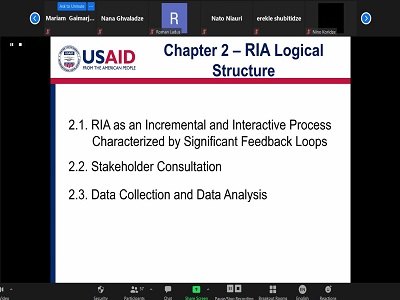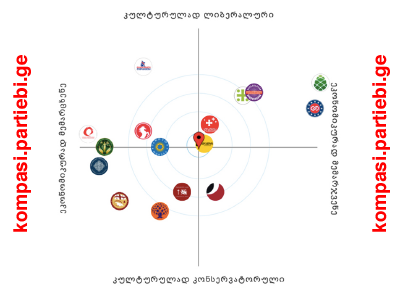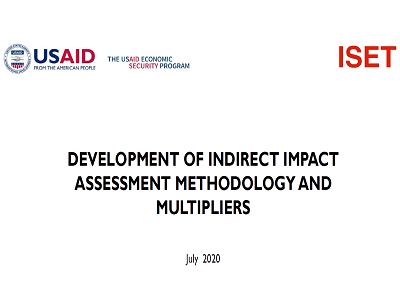
The International School of Economics at TSU (ISET) and ISET Policy Institute are looking for a Communications Specialist. Dimension and Scope: &bul...
Read more




![]()
![]()
![]()
![]()
![]()

Hosted and moderated by ISET Policy Institute’s Salome Gelashvili, Acting Head of the Agricultural and Rural Development Policy Research Center,...
Read more
We were thrilled to see Salome Gelashvili, head of the ISET-PI Agricultural Policy Research Center (APRC), actively participate in a UNDP Georgia onli...
Read more
Our latest online presentation highlighted women’s rights in Georgia and crucially considered their role in employment, childcare, and within so...
Read more
On November 8, ISET was visited by Mr. Juha Kahkonen, Deputy Director of the Middle East and Central Asia Department of the IMF, who gave a presentati...
Read more
Considering the significance of a green post-COVID recovery, alongside the importance of maintaining an ecological diverse economy, ISET Policy Instit...
Read more
ISET’s Policy Institute is proud to announce the unveiling of its Regulatory Impact Assessment (RIA) Manual. The ISET Director, Tamar Sulukhia, ...
Read more
Parliamentary elections are just around the corner. A well informed and empowered citizen is central to the outcome of elections that will be in the b...
Read more
On July 21, ISET Policy Institute (ISET-PI) held an online presentation 'Development of Indirect Impact Assessment Methodology and Multipliers'. The ...
Read more
Under ISET affiliation Luc Leruth, the Lead Economist in the Policy Institute’s Governance and Social Policy Research Center, has recently been ...
Read more
In early February, Dr Leruth gave a presentation to the G20's Task Force on Multilateralism and Global Governance. His address, entitled "Identifying ...
Read moreWhat do the CCI numbers mean? If one selects a random sample of 100 Georgians and asks them to assess their personal economic situations and the state of the economy as a whole, there will be some in this group who think that the situation is rather positive, some who consider it to be neutral, and some whose perceptions are negative. When our index has a value of -8 points, this means that on average, in such a sample of 100 people will be 8 less Georgians who have a positive view than Georgians who think that the situation is negative (neutral assessments do not count). A sample of size 100 in which 30 people think that the situation is rather good, 38 think that it is bad, and 32 are neutral, would consistent with such a value. So, if we would base the CCI exclusively on 100 persons, the index would always be an integer number. Yet in fact we base our estimation on a sample of approximately 350 Georgians, and that is why usually we end up with non-integer values.
The consumer confidence indicator is the arithmetic average of the balances (in percentage points) of the answers to the questions on the financial situation of households, the general economic situation, unemployment expectations (with inverted sign) and savings, all over the next 12 months. On the basis of the distribution of the various options for each question, aggregate balances are calculated for each question. Balances are the difference between positive and negative answering options, measured as percentage points of total answers. In particular, if a question has three alternative options: "positive", "neutral" and "negative", and if P, E and M (with P+E+M=100) denote the percentages of respondents having chosen respectively the option positive, neutral, and negative, the balance is calculated as:
B = P - M
In the case of questions with six options, i.e. the three options above plus "very positive", "very negative" and "don’t know", the balances are calculated on the basis of weighted averages. If P, E and M have the same meaning as in the previous paragraph, while PP denotes the percentage of respondents having chosen the option "very positive", MM the percentage of respondents having chosen the option “very negative” and N is the percentage of respondents without any opinion (so that PP+P+E+M+MM+N=100), balances are calculated as:
B = (PP + 0.5P) − (0.5M + MM)
It is clear from the expressions above that balance values range from −100, when all respondents choose the negative option (or the most negative one in the case of five-option questions) to +100, when all respondents choose the positive (or the most positive) option.


On the 13th of November, ISET was visited by Joey Cherdarchuk of Darkhorse Analytics, a Canadian company specializing in data science and information design. The firm is dedicated to helping organizations and individuals present their data in a clear...
Read more
September 17-18 2018, the APRC’s Rati Kochlamazashvili and Pati Mamardashvili conducted a training exercise for Civil Society Organizations (CSO) running Social Enterprises (SE) in value chain analysis and development. In the recent years, SE ...
Read more
Georgia committed to harmonize its electricity market legislation with EU Third Energy Package and liberalize it according to the accession protocol with the Energy Community. These structural changes are expected to contribute to a more efficient fu...
Read more
ISET Policy Institute collaborated with Gesellschaft für Internationale Zusammenarbeit (GIZ) starts a training course about integrating ecosystem services into local development planning. Integrating Ecosystem Services into Local Development Pl...
Read more
ISET-PI trains Competition Agency of Georgia Staff in the basics of econometrics and STATA. The objective of the training is to strengthen the capacity of the Competition Agency staff to use STATA to conduct independent data analysis, run OLS regress...
Read more
ISET is implementing a new training program, "Economics, Finance and Banking," with VTB Bank. The aim of the program is to introduce VTB Bank's employees to the major principles of economics, finance and banking. The training program is now being co...
Read more